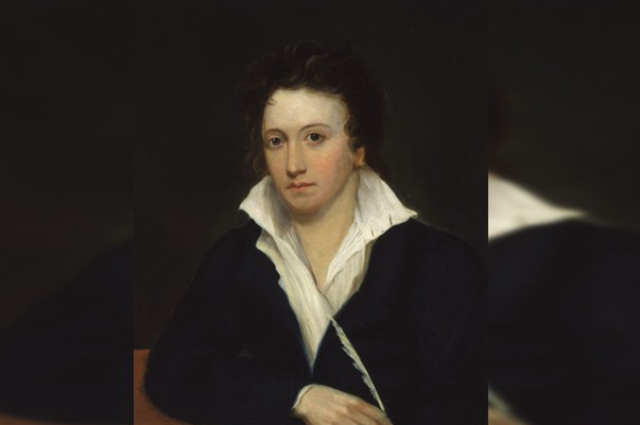Shelley, in his ‘Ode to the West Wind’, describes the phenomenon of a tumultuous storm and the effect it has on nature around him and on himself. In a note published along with the poem, Shelley describes the conditions that inspired him to write the poem. He says that he happened to be in the woods of Arno in Italy when the tempestuous wind rose and caught him in the middle of it here The fact that the poet is present, and eventually becomes a part of the phenomenon which he describes, is integral to the understanding of Romantic poetry. A Romantic poet, here Shelley, is inherently the part of the changing experience he describes, say when Wordsworth is writing about Tintern Abbey, he was actually present at Tintern Abbey which provides him the authority to comment upon the effect the tranquil surroundings have on him, the poetry is the result of that experience which takes us to the definition of the Romantic understanding of poetry - ‘A spontaneous overflow of powerful emotions recalled in tranquility’, the subject of the poem, in case of Shelley- the West Wind, has that effect of being “impetuous” – ‘spontaneous overflow’, of “ powerful emotions” which our poet announces as the prophecy of the West Wind. The Romantic poet puts himself in the position of the prophet figure to declare to the world his personal truth conceived in a moment of epiphany. The poet’s truth is highly esoteric and subjective, and is revealed to him as a part of a divine experience, which makes him see beyond reality. Shelley here is able to see beyond the physical effects of the storm because he has been spiritually inspired to do so.
Much of the prophetic quality of the poem rests in the way it is read out, the poet intends his work to be read out loud-“ by the incantation of this verse” and hence the intonation makes the poem sound’ like a prophecy. The poem begins with a series of heavily stressed words –“ O wild West Wind thou breath of Autumn’s being”, the heavy syllables give a power filled break into the poem and the readers are ushered into the poem in a way that their speed of reading is in synchronization with the rapid movement of the wind. The effect this rapidity brings is also carried out by the way the poet puts into use the working of the rhyme scheme. To fully understand this working, we need to look at the form in which each of the verses is composed. Each verse comprises four tercets and a concluding couplet which add up to fourteen hence making each verse an individual sonnet with a break in the traditional Shakespearean sonnet form of three quatrains and a couplet, this distortion in the form of the sonnet brings an effect of the words being dispersed with the wind much like ‘dead leaves’ are, to bring about a unification to this dispersed format Shelley fixes the rhyme scheme of every consequent tercet based upon the sound of the last word of the second line of the previous tercet, for example -
“O wild West Wind, thou breath of Autumn’s being,
Thou, from whose unseen presence the leaves are dead
Are driven, like ghosts from an enchanter fleeing,
Yellow, and black, and pale, and hectic red,
Pestilence–stricken multitudes: :O thou,
Who chariotest to their dark wintry bed”
Here in the first two tercets of the poem, the rhyme scheme of the second tercet is determined by the sound effect of the last word of the second line of the previous tercet, - dead rhymes with red and bed and subsequently thou, last word of the second line of the second tercet rhymes with ‘low’ and ‘blow’ in the third tercet.
This technique applied by the poet tends to create an effect of being carried away by the wind from one part to the other, thus sewing the gaps created by the distortion in the sonnet form- chaos is balanced by unification.
This motif is central to the theme of the poem- rejuvenation emerging out of destruction, the agent of which is the West Wind. The adjectives used for the wind – “ Destroyer and preserver”, “O uncontrollable”, “ tameless, and swift, and proud” are balanced by “to quicken a new birth”. The wind creates as it destroys. It scatters seeds which would grow into flowers during spring, it scatters clouds that bring rain, it rumbles the oceans and makes the waves in sync with itself, it has a very grand and phenomenal effect over nature, which the poet wishes to profess. He aspires to be one with the wind, he wants to be the prophet to the people and convey what the wind makes dawn upon him – the promise of rejuvenation, of creation. The poet experiences a change within himself and wants to be the medium of that change caused by the wind:
“Make me thy lyre” and “Scatter … my words among mankind!
Be through my lips to unawakened earth
The trumpet of a prophecy! O Wind”.
The poet turns himself into a prophet figure and, along with his message, which is conveyed through symbolisms such as that of sparks arising from a dead fire, he makes it evident that “if Winter comes, can Spring be far behind?”.
Shelley is a poet of revolution and dynamism, and his personal aspirations are reflected in the form, the language, in the capitalisation of words, which in turn moderate the intonation, in the structure, and the theme of the poem. He makes his poem both a prophecy and sound like one. He has deep reverence for the phenomenal West Wind and respects it as being the only constant in the ever-changing cycle of change, an idea he also conveys in ‘The Revolt of Islam’:
“The one remains, the many change and pass”.

